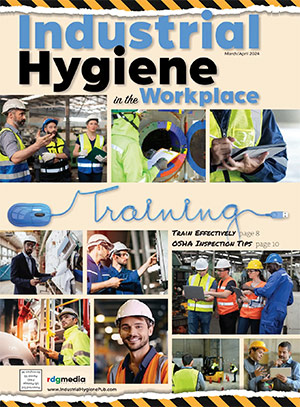Going Beyond Dust Hazard Analysis
A safety expert walks agricultural and food processing companies through dust hazard analysis, NFPA 61 compliance, and leading options to address the risk of combustible dust explosions
For owners and operators in the agricultural and food processing industries, January 1, 2022, was the deadline for completion of a dust hazard analysis (DHA) for existing facilities in accordance with Chapter 7 of the National Fire Protection Association’s Standard 61 (2020), for the Prevention of Fires and Dust Explosions in Agricultural and Food Processing Facilities. NFPA 61 and other related NFPA Standards detail essential strategies and procedures for the protection of people, processes and property from the hazards presented by fires and dust explosions in facilities handling, processing, and storing bulk grains such as corn, wheat, oats, barley, sunflower seeds, and soybeans, their by-products, as well as other agricultural related combustible dusts. All new processes and facilities handling and generating combustible dusts are now required to perform a DHA.
Appendix F of NFPA 61 (2020) provides a comprehensive checklist which serves as a blueprint for generating a DHA. This check list includes evaluating the dust explosion protection for process equipment that can often be at risk such as bucket elevators, conveyors, grinders, silos, and systems for spray drying and dust collection.
Recognizing the risk of non-compliance along with the potential liability, grain and food processors have completed their mandated DHA, and are working through the determination of what the next steps are to comply with NFPA 61 as a component of their local jurisdictional safety requirements. This includes making decisions relating to the explosion protection of process equipment which can represent a considerable financial investment requiring careful consideration.
Following preparation of the DHA document, the job is not finished. The DHA team must then develop an action plan for the identified hazards and prepare a prioritized action item list with specific tasks, assigned parties, target timeframes, and required resources. This serves as both a road map for hazard reduction and a working document demonstrating reasonable effort towards managing risk. Recommendations for addressing deficiencies in managing combustible dust hazards must be documented and addressed in a timely fashion acceptable to the authority having jurisdiction.
“The DHA is only the starting point for bringing a facility and process into compliance with the relevant NFPA standards. The next step is implementation. Before doing so, owner/operators should consider some key questions,” says Clive Nixon, Sales Manager at Tulsa, OK-based BS&B Pressure Safety Management, a manufacturer of a broad range of dust explosion prevention and protection technologies.
Nixon advises owners and operators of facilities to ask these questions:
- Was the DHA completed by a person or team having credible experience in the facility and its process equipment with knowledge on the application of the relevant NFPA standards?
- Are there any areas of the DHA that are missing or incomplete?
- Have there been any relevant changes to the facility or process that merit an update to the DHA?
- Are all components of the DHA clear with specific action items or are clarifications needed?
- Do we know how to implement the action items arising from the DHA?
- What are our protection options to achieve compliance?
Nixon recommends reviewing or updating the DHA with a safety expert if anything is missing or unclear, since the risk and potential liability of insufficient compliance and protection can be very costly if a combustible dust explosion were to occur in a facility.
“There are a range of solutions to provide cost-effective protection against the combustible dust hazard, but each facility’s choice will vary depending on their specific needs. The technology selection should not only consider factors such as the nature of the dust hazard and its characteristics, but also equipment location, strength, operating pressures, temperatures, and process interconnections,” says Nixon.
“Owners and operators are best served by working with an expert supplier with access to a complete range of safety solutions for a particular application. They should be aware that a supplier having only one particular solution may be biased in their recommendations.”
According to Nixon, the primary options for explosion protection & prevention in grain and food processing facilities broadly include explosion venting, explosion suppression, and explosion isolation.
Explosion Relief Venting
Venting is the most widely adopted protection mechanism because it frequently provides a convenient and economical solution. While it is often perceived as a fit-and-forget solution, it does require regular inspection per NFPA 68. It is often the most practical solution for equipment located outside or near to an outside wall where there is a clear path for the projection of a dust explosion fireball to a safe area where it will not endanger people or damage equipment or nearby structures.
During the early stages of a dust explosion, explosion relief vents open rapidly at a predetermined burst pressure. This allows the rapidly expanding combustion gases and dust / air mixture to escape to the atmosphere and limit the pressure generated within the equipment to calculated safe limits. Most agricultural dust materials would develop a pressure in excess of 100 psi in a fraction of a second if the process enclosure was sufficiently strong.
As an example, explosion panels can be applied to bucket elevators located outside, or close to an outside wall where the dust explosion can be safely vented to the outside via short vent ducts. These vents are mounted onto the leg casing(s) and elevator head and open rapidly to relieve the explosion pressure of a rapidly burning dust, known as a deflagration.
For venting solutions, the method of sizing vents and the strength of the equipment is an important consideration. The sizing of vents for bucket elevators handling raw grain is covered by NPFA 61. For processed grain, NFPA 61 defers to NFPA 68, in which the required strength of the equipment is dictated by the material explosivity index (Kst value). The vent area calculation basis is not the same for raw grain and processed grain, with the arising vent quantity and position typically different for the two forms of material.
The path for the explosion relief flame ball and the accessibility of the vent panels for occasional inspection and maintenance are important considerations when selecting this method of protection. These are covered in NFPA 61 – 2020 section 9.3.14 and NFPA 68 – 2018 section 8.8.
Flamefree™ Vents
According to Nixon, there are some applications such as where the boot of a bucket elevator or other food processing equipment is inside a building or below grade. That creates a challenge for explosion relief venting due to the release of flame and pressure into a confined space, requiring different protection approaches such as flamefree venting and suppression.
Where equipment is located inside, or where people or combustible material are present, conventional vents, which will release a fireball, can be replaced by flamefree vents. These vents are designed to diffuse the pressure wave and eliminate the flame that would normally be projected by a vented explosion. For applications outside of the grain, feed and food industries, consideration should be given to the potential of toxic byproducts being generated during activation of these devices when located inside a building. For all applications, a safety zone shall be established around the flamefree vent which will emit hot gases for a short time when venting a deflagration. Additionally, the size of the room in which the protected equipment is located must be factored into the evaluation of this protection approach. This is needed to avoid pressurizing small rooms when venting the expanding gases from a deflagration.
Flamefree vents consist of a conventional vent mounted in front of a housing which incorporates a stainless-steel mesh that extracts the heat of the deflagration while allowing the explosively expanding gases to be discharged safely. This mesh arrests the flame front and acts at least partially to filter the release of dust and soot. The stainless-steel mesh represents a restriction to flow, and an allowance is made for this by assigning a vent efficiency to ensure selection of the correct size of vent. The mesh is configured to partially absorb the pressure wave of the expanding gases and to capture dust and soot particles to a varying degree that determines the ‘vent efficiency’ of the flameless venting device. Vent efficiency may typically range between 50% and 95%, which means that a flamefree vent area calculation is going to be larger than a conventional vent for the same application. Great care on this point is required whenever considering replacement of a conventional vent with a flamefree vent.
The weight and vent efficiency of flamefree vents are considered when selecting them for applications such as the protection of bucket elevators. The relevant codes are NFPA 61 – 2020 section 9.3.14 and NFPA 68 – 2018 section 8.8.
Explosion Suppression
Explosion suppression systems are designed to suppress a deflagration in its initial stage before destructive pressure can be generated. This is in contrast to explosion venting, which allows the deflagration to proceed to completion while exposing the equipment to combustion temperatures.
Explosion suppression equipment is designed to respond in milliseconds to the signal generated by pressure or flame detectors monitoring the process. This results in explosion suppressors rapidly discharging a flame quenching agent, such as sodium bicarbonate, into the protected equipment volumes. This effectively halts the explosion in its infancy and results in a reduced explosion pressure that is safe for the protected equipment.
‘Think of explosion suppression as a fire extinguisher that triggers automatically but at about 1,000 times the speed,” says Nixon.
Suppression systems can be desirable, because the speed of cleanup and refit allows for a quick return to production. With venting or flamefree venting, the explosion fully develops in the process equipment, requiring cleanup, mitigation of fire-related damage, and other consequences that take time to get the process back into operation.
The suppression method of protection is often applied to double leg bucket elevators, used in grain handling. Protection consists of explosion detection and suppression of the elevator head and boot section, as well as explosion isolation of the leg casings, feed and discharge points, and dust extraction points.
Suppression of single leg bucket elevators is also practical in grain applications, although the open internal volume between boot and head will require additional extinguishing agent injection points. Most importantly, whether applied to a double leg or single leg bucket elevator, suppression systems are recommended to incorporate explosion isolation to prevent the propagation of an explosion to connected equipment volumes such as silos.
Explosion Isolation
Explosion isolation is a vital component to any explosion protection strategy. The propagation of a dust explosion can result in secondary events in connected equipment which can be more destructive than the initial event. Isolation should be considered for all process interconnections such as inlet ducts, discharge ducts, and dust extraction points.
Although explosion isolation is a component of explosion suppression systems, it is not an intrinsic feature of explosion venting systems. When explosion vents are selected for explosion protection, a means of chemical or mechanical isolation must be considered to prevent explosion propagation to interconnected process volumes via inlet ducts, outlet ducts, conveyors, and dust extraction points. See NFPA 69 for compliant solutions and refer to NFPA 61-2020 section 9.7.4.
While it can be tempting for the owner / operator to consider applying partial protection to a process system, care must be taken to manage the risk both from and to connected equipment. A piece of unprotected equipment can be the Achilles heel to a facility protection plan.
For grain and food processors, there are many critical decisions involved beyond the DHA in selecting dust explosion prevention, protection, and mitigation equipment given the areas at risk, the methods of protection, relevant NFPA codes, other jurisdictional requirements, and the type of material processed.
However, careful attention to dust explosion mitigation and isolation in processing equipment can ensure the protection of both facility personnel and infrastructure. This will also limit the potential for preventable production and business interruptions.
For more information, contact BS&B Safety Systems at 7455 East 46th Street, Tulsa, OK 74145-6379, (918) 622-5950, e-mail: sales@bsbsystems.com or visit www.bsbsystems.com .
Share on Socials!
Interpretations by OSHA for confined space compliance in basements
NIOSH awards $1.5 million for research to reduce exposures to workplace hazards through robotic technology
US Department of Labor expands OSHA’s ability to protect all workers by certifying special visa applications to ensure effective enforcement
Leaders in Industrial Hygiene
Council for Accreditation in Occupational Hearing Conservation (CAOHC)
Subscribe!
Sign up to receive our industry publications for FREE!








